An A to Z of the Piano Trio Repertoire: “B” Composers Part
2
by David Barker
As I mentioned in my Introduction, it was a concert performance of the First Trio by Johannes Brahms (1833-1897, Germany) which sparked my love for the combination. It was by the Kalichstein-Laredo-Robinson Trio, and I was rather surprised to be quite underwhelmed when I listened to their recording of the work recently.
As with Beethoven, I will not be attempting to list or discuss all recordings of
the Brahms trios.
The three Brahms trios are among the most recorded in the genre, and rightly so. He, of course, substantially revised his first trio, but did not destroy the original one. As a consequence, recordings of both versions exist. How do you recognise which is which, if it isn’t labelled as original (1854) or revised (1889)? Simply the duration: Brahms drastically trimmed the work in the revision, especially the first and last movements. If the finale is in the vicinity of nine minutes, you have the original version. The first movement is less reliable as some trios choose not to observe the repeats. There are a number of recordings of the original version, some presented alongside the revised one for reasons of historical curiosity. In the table below, listing details of the works discussed here, I have indicated the original version with an asterisk. There is also an A major trio, discovered three decades after his death, which has not been universally accepted as having been written by Brahms, but it has a number of recordings. You can read more about its history on
Wikipedia.
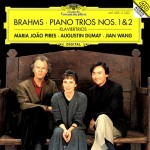 My gold standard for Brahms 1 & 2 has been for a long time the 1968 Decca recording of Julius Katchen, Josef Suk & Janos Starker
(they also recorded No. 3). After some wide-ranging listening for this survey, I find myself surprised to that only one recording – Maria Joăo Pires, Augustin Dumay and Jian Wang – make a challenge, and indeed is the victor. This survey, in toto, will undoubtedly provide me with many rewards in terms of new works and recordings: to find a new pinnacle for Brahms 1 & 2 is certainly one of them.
My gold standard for Brahms 1 & 2 has been for a long time the 1968 Decca recording of Julius Katchen, Josef Suk & Janos Starker
(they also recorded No. 3). After some wide-ranging listening for this survey, I find myself surprised to that only one recording – Maria Joăo Pires, Augustin Dumay and Jian Wang – make a challenge, and indeed is the victor. This survey, in toto, will undoubtedly provide me with many rewards in terms of new works and recordings: to find a new pinnacle for Brahms 1 & 2 is certainly one of them.
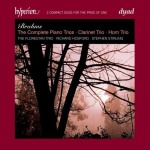 The Florestan Trio has been a constant in my piano trio listening for almost as long as the Brahms, but I have only recently made the acquaintance of their recording of these works. This was the result of a reservation related to my preference for a more Romantic than Classical Brahms. I felt that the poise and elegance of the Florestans would place them in the latter camp, and so it has eventuated. It is beautifully played, but it is Brahms as Classicist, and I found myself wanting to hear a little more passion and drama. If, like me, you prefer Emil Gilels in the Brahms concertos to Leon Fleisher, for example, then you will almost certainly have a similar view on the Florestans. The reverse is, of course, true.
The Florestan Trio has been a constant in my piano trio listening for almost as long as the Brahms, but I have only recently made the acquaintance of their recording of these works. This was the result of a reservation related to my preference for a more Romantic than Classical Brahms. I felt that the poise and elegance of the Florestans would place them in the latter camp, and so it has eventuated. It is beautifully played, but it is Brahms as Classicist, and I found myself wanting to hear a little more passion and drama. If, like me, you prefer Emil Gilels in the Brahms concertos to Leon Fleisher, for example, then you will almost certainly have a similar view on the Florestans. The reverse is, of course, true.
I listened to a number of prominent recordings, and found that the divide between Classical and Romantic approaches could be applied readily to most. It is, of course, a very subjective way, but I feel there is no doubt that most trios have decided on either the restrained (Classical) or passionate (Romantic) path. I should make it clear that it is not a matter of tempo, rather dynamics and accents that distinguishes the two.
It would appear that the Classical approach is the current thinking, as most of the recent recordings belong in this camp. Of those, the Chung, Gould, Grieg, Storioni and Wanderer Trios can all be recommended along with the Florestans. While I personally might prefer a different approach, that didn’t stop me finding many pleasures in these performances.
There were two Classical style recordings with which I had major problems. The Altenberg Trio Wien seemed to have a train to catch, as everything was played at a faster tempo than the norm. By way of illustration, they run through the First Trio (revised version) in under 34 minutes, when almost every other version I checked is over 36 minutes. A couple of minutes in well over half an hour may not seem much, but every accent is simply ploughed through as though it was not there. The subtle pauses to emphasise phrases that most everyone employs are either ignored or abbreviated so that they miss the point. Clearly, the Altenbergs had something very definite in mind, but it wasn’t Brahms for me. The other problem one was the Gutman Trio, also fast, though much more characterised. Unfortunately, they seemed to see Brahms as another Mendelssohn, which isn’t my picture of Brahms either. In the Gutman’s defence, I will cite the review of my colleague Ian Lace who described their performances as “winning”.
Obviously Romantic school recommendations are dominated by the two I have already put at the top of my tree. Others that I have enjoyed are the Munich Trio (despite one of the players having an
apparently severe sinus problem), Trio Solisti (except for an overly rushed trio section in the scherzo of Trio 1, the Macquarie Trio (though some of the tempos are perhaps a little broad), and the Eroica Trio (no reservations).
The Beaux Arts Trio have recorded the Brahms twice: the first, from 1967, is available as the “Complete Piano Trios” on a Phillips/Decca Duo with the clarinet & horn trios. The second, from 1987, has Trios 1-3 and the A major and is part of the Originals series. Their interpretation mellowed over the two decades, moving from an early entry in the Classical camp, to a broader, more poetic and Romantic one. Do I have a preference? I find myself liking elements of each, but neither enough to add them to my collection.
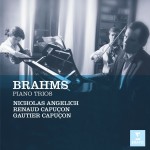 There is one recording which eludes my attempt to place it in my Classical/Romantic divide, and perhaps it is for that reason that I have yet to make up my mind as to whether it is one of the best or one of the worst. I realise how ridiculous that statement must seem, but it is precisely how I feel. I am referring to the recording by the renowned soloists Nicholas Angelich & the brothers Capuçon. Two of my colleagues have nominated it for Musicweb International Recommends and a reviewer from another publication, whose opinion I usually agree with, has described it as the version he would take with him when he dies. I have also seen the word “controversial” applied to it. My first impression was negative: it seemed to be Brahms filtered through Ravel and Fauré. I decided to give it a longer audition, and some of my reservations began to disappear. The feeling of Frenchness remains, which I don’t believe is a case of imposing my knowledge of the origin of the players (Angelich is American, but educated in Paris) on their interpretation. Theirs is a leisurely and almost gentle take on Brahms, without losing the essential Romantic passion. I have a sense of them showing me aspects of the works I’d not heard before, which I previously encountered with Joyce Yang and the Alexander Quartet with the Schumann quintet. There too I had an initial sense of discomfort – “surely this isn’t the work I know” – followed by revelation. I haven’t reached the latter stage quite yet with this one, but it does seem to be on the cards. Whatever my final thoughts, you definitely need to listen to first (try Spotify) before purchasing.
There is one recording which eludes my attempt to place it in my Classical/Romantic divide, and perhaps it is for that reason that I have yet to make up my mind as to whether it is one of the best or one of the worst. I realise how ridiculous that statement must seem, but it is precisely how I feel. I am referring to the recording by the renowned soloists Nicholas Angelich & the brothers Capuçon. Two of my colleagues have nominated it for Musicweb International Recommends and a reviewer from another publication, whose opinion I usually agree with, has described it as the version he would take with him when he dies. I have also seen the word “controversial” applied to it. My first impression was negative: it seemed to be Brahms filtered through Ravel and Fauré. I decided to give it a longer audition, and some of my reservations began to disappear. The feeling of Frenchness remains, which I don’t believe is a case of imposing my knowledge of the origin of the players (Angelich is American, but educated in Paris) on their interpretation. Theirs is a leisurely and almost gentle take on Brahms, without losing the essential Romantic passion. I have a sense of them showing me aspects of the works I’d not heard before, which I previously encountered with Joyce Yang and the Alexander Quartet with the Schumann quintet. There too I had an initial sense of discomfort – “surely this isn’t the work I know” – followed by revelation. I haven’t reached the latter stage quite yet with this one, but it does seem to be on the cards. Whatever my final thoughts, you definitely need to listen to first (try Spotify) before purchasing.
|
Performers |
Label |
Catalogue Number |
Coupling(s) |
|
Trio Altenberg Wien (1-3 & 1*) |
Challenge Classics |
CC72023 |
-- |
|
Beaux Arts Trio (1-3) |
Philips/Decca |
4383652 |
Clarinet & horn trios |
|
Beaux Arts Trio (1-3 & A) |
Philips/Decca |
4780338 |
-- |
|
Chung Trio (1) |
Decca |
421 4252 |
Mendelssohn 1 |
|
Eroica Trio (1 & 2) |
EMI/Warner |
5571995 |
Arrangements |
|
Florestan Trio (1-3) |
Hyperion |
CDD22082 |
Clarinet & horn trios |
|
Gould Piano Trio (1-3, 1* & A) |
Quartz |
QTZ2067 |
Clarinet & horn trios |
|
Grieg Piano Trio (1 & 2) |
Simax |
PSC1099 |
-- |
|
Gutman Trio (1 & 3) |
Brilliant Classics |
94474 |
-- |
|
Kalichstein-Loredo-Robinson Trio (1-3) |
Vox |
CD3X3029 |
Dvorak 4, Mendelssohn 1 & 2 |
|
Macquarie Trio (1-3, 1* & A) |
ABC |
4726682 |
-- |
|
Trio Solisti (1 & 3) |
Marquis |
MAR329 |
-- |
|
Storioni Trio (1 & 2) |
Pentatone |
PTC5186328 |
-- |
|
Trio Wanderer (1-3) |
Harmonia Mundi |
HMC901915/6 |
Piano quartet 1 |
|
Angelich, Capuçon & Capuçon (1-3) |
Virgin/Erato |
5456535 |
-- |
|
Istomin, Stern & Rose (1-3) |
Sony |
Various releases |
-- |
|
Katchen, Suk & Starker |
Decca |
4211522 (1 & 2) |
-- |
|
4480922 (1-3) |
Cello sonata 2, FAE sonata |
|
Pires, Dumay & Wang (1 & 2) |
DG |
4470552 |
-- |
Gaetano
Braga (1829-1907, Italy) is not the Gaetano one thinks of when
contemplating nineteenth century Italian composers. His Trio De Salon is
absolutely what it says on the label, and is a perfectly charming example
of that style of music. The other chamber works on the recording
are equally entertaining, particularly the Soirée à Naples for
the unusual combination of three
cellos and piano.
|
Performers |
Label |
Catalogue Number |
Coupling(s) |
|
Sabatini, Morena, Di Illio |
Bongiovanni |
GB5119 |
Chamber miniatures |
Alexander Borodin (1883-1887, Russia) wrote a number of chamber works early in his career, whilst developing his voice, before heading off into chemistry. The much loved Second String Quartet comes
from his maturity, so don’t expect the same level of inspiration in this trio from 1861. It is apparently incomplete, the final movement being lost. I have the Moscow Trio’s recording from its original release on a long-gone label (Chant du Monde), now reissued by Brilliant in multiple packages (review). I have listened to samples from the Praga recording, and I must say that it gives the music more energy, but whether you wish to pay full price to get this relatively minor work will depend on whether you wish to explore more of Borodin’s chamber music.
|
Performers |
Label |
Catalogue Number |
Coupling(s) |
|
Kinsky Trio Prague |
Praga |
DSD250288 |
String sextet & trio |
|
Moscow Trio |
Brilliant Classics |
93373 |
Borodin chamber music |
|
94410 |
Borodin Edition |
|
94712 |
Russian Piano Trios |
|
Romantic Trio |
Russian Compact Disc |
RCD10402 |
Tchaikovsky |
|
Emil Gilels, Dmitri Tziganov, Sergey Shirinsky |
Doremi |
DHR7921 |
Collection |
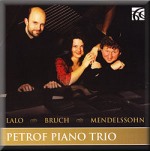 Max Bruch (1838-1920, Germany) wrote most of his chamber music late in his career, though not this trio. It dates from 1858, much influenced by Mendelssohn and only occasionally gives hints of his mature works. It must also be said that the piano was not his instrument; accordingly this work’s best parts are for the strings. Recordings are fairly scarce, and not from any well-known group. The only one reviewed in these pages is the Petrof Trio on Nimbus, which was well received (review ~ review).
Max Bruch (1838-1920, Germany) wrote most of his chamber music late in his career, though not this trio. It dates from 1858, much influenced by Mendelssohn and only occasionally gives hints of his mature works. It must also be said that the piano was not his instrument; accordingly this work’s best parts are for the strings. Recordings are fairly scarce, and not from any well-known group. The only one reviewed in these pages is the Petrof Trio on Nimbus, which was well received (review ~ review).
|
Performers |
Label |
Catalogue Number |
Coupling(s) |
|
Arensky Trio |
Antes |
BM319146 |
Brahms: String sextet 1 (arr. trio) |
|
Trio Estampe |
Arties |
AREC002 |
8 Pieces |
|
Petrof Trio |
Nimbus |
NI6219 |
Lalo 1, Mendelssohn 1 |
|
Catherine Wilson & Friends/Ensemble Vivant |
Doremi |
DHR71134 |
Glick: Old Toronto Klezmer Suite, Mendelssohn: Piano sextet |
|
Opening Day |
9359 |
|
Yuval Trio |
Centaur |
CRC2374 |
Chajes, Pfitzner |
|
Romeo |
7225 |
Dvorak 2, C Schumann |
Léon Böellmann (1862-1897, France) won a prize from the Société des Compositeurs in Paris with his trio written two years before his death. It sits firmly in the Saint-Saëns school, in that it is well-crafted, elegant and charming. Given the equally attractive couplings
on the MDG release, including arrangements for trio – it is not clear by whom – of two of his organ miniatures Les heures mystiques, this can certainly be recommended.
|
Performers |
Label |
Catalogue Number |
Coupling(s) |
|
Trio Parnassus |
MDG |
30317552 |
Piano quartet, Pieces for cello & piano, Les heures mystiques |
|
Trio Podhadka |
-- |
TPR001 |
Piazzolla: Four seasons |
|
Prunyi, Banfalvi, Fehervari |
Marco Polo |
8223524 |
Piano quartet |
I expected more from the trio of Tomás Bretón (1850-1923, Spain), both in quality and Spanish character. It is a work of his maturity (1891) and was sufficiently interesting to attract three of my colleagues to review the Naxos recording. While none of them was falling over themselves to proclaim a masterwork, I imagined something with more colour and interest. The competition is Naxos versus itself, and the older Marco Polo recording certainly loses out, though if you want his quartet, there are no alternatives. The Four Spanish Pieces are simply salon pieces, a pleasant if uninspiring way to spend twenty minutes.
|
Performers |
Label |
Catalogue Number |
Coupling(s) |
|
LOM Trio (trio & pieces) |
Naxos |
8570713 |
-- |
|
Oravecz, New Budapest Qt (trio) |
Marco Polo |
8223745 |
String quartet |
Marco Bossi (1861-1925, Italy) is best known for his organ music, and I can’t say that his two trios, written in 1896 and 1901, were particularly memorable (review). They are certainly written in the grand style, particularly the Trio sinfonico at more than 35 minutes, but unfortunately there isn’t sufficient content to sustain such large works. I have listened to the Tactus recording fully, and it is compromised by terrible sound quality. Sampling the Hungaroton suggests that it is somewhat better in that regard.
|
Performers |
Label |
Catalogue Number |
Coupling(s) |
|
Hungarian Piano Trio |
Hungaroton |
HCD32293 |
-- |
|
SchuberTrio |
Tactus |
TC862704 |
-- |
There is a fascinating trio by Francisco Braga (1868-1945, Brazil), written in either 1905 or 1937, depending on which source you read. Alas, its only recording seems to be unavailable, though it has been put on Youtube; hence I have included it in my Wishlist.
| Performers |
Label |
Catalogue Number |
Coupling(s) |
| Trio Brasileiro |
LAMI |
?? |
Gnatli, Lacerda, Prado |
Mélanie Bonis (1858-1937, France) was forced by the attitudes of the time to publish under the name “Mel”. Her two miniatures for trio – Soir and Matin – written in 1907, are elegant, tuneful and very French. The MDG recording has the advantage with her two fine piano quartets. There is also a Suite Orientale, which was written with the option of flute instead of violin, and it is only the flute version that has been recorded.
|
Performers |
Label |
Catalogue Number |
Coupling(s) |
|
Trio George Sand |
Zig Zag Territoires |
ZZT120101 |
Faure, Ravel |
|
Mozart Piano Trio |
MDG |
6431424 |
Piano quartets |
 The music of Frank Bridge (1879-1941, Britain) underwent a drastic change, far more than a simple evolution, after the First World War. His warm Romantic style became cold, brittle and angst-ridden. The Phantasie Trio won the 1907 Cobbett competition, and is everything you might expect from his earlier style. John France in his review of the Naxos release describes it as “a sunshine work”. The second trio, from 1928, is a very different matter. A critic writing about the premiere commented that Bridge had “put technical interest before aesthetic pleasure”. It is regarded by some as his finest chamber composition, by others as very hard going. If you have read either of the previous instalments of this survey, you will know to which view I ascribe. The Miniatures come from the year after the Phantasie, and find Bridge wearing his folksong/salon music hat. They were apparently written (in three sets of three) for one of his pupils and her two sisters to play – lucky them.
The music of Frank Bridge (1879-1941, Britain) underwent a drastic change, far more than a simple evolution, after the First World War. His warm Romantic style became cold, brittle and angst-ridden. The Phantasie Trio won the 1907 Cobbett competition, and is everything you might expect from his earlier style. John France in his review of the Naxos release describes it as “a sunshine work”. The second trio, from 1928, is a very different matter. A critic writing about the premiere commented that Bridge had “put technical interest before aesthetic pleasure”. It is regarded by some as his finest chamber composition, by others as very hard going. If you have read either of the previous instalments of this survey, you will know to which view I ascribe. The Miniatures come from the year after the Phantasie, and find Bridge wearing his folksong/salon music hat. They were apparently written (in three sets of three) for one of his pupils and her two sisters to play – lucky them.
If you want all Bridge’s music for trio, then the well-performed Naxos disc is a bargain. The other option is the Dussek trio on Meridian, though Rob Barnett suggests their cool performance is not as well suited to the pre-war works. The Dartington Trio on Hyperion Helios dispense with the Miniatures, bringing in the Phantasy Quartet, another Cobbett work, and the recording has been very well received. If you are principally interested in the Phantasie, then Nick Barnard described the Dimension Trio’s performance as the finest he has heard.
|
Performers |
Label |
Catalogue Number |
Coupling(s) |
|
Borodin Trio (2) |
Chandos |
CHAN8495 |
Bax |
|
Cantamen (1) |
BMS |
BMS418CD |
Friskin: Phantasie, Ireland: Phantasie trio, Moeran |
|
Dartington Trio (1 & 2) |
Hyperion |
CDH55063 |
Phantasy quartet |
|
Dimension Trio (1) |
Champs Hill |
CHRCD060 |
Ireland: Phantasie trio, Schoenberg: Verklarte nacht, Suk: Elegy |
|
Dussek Trio (all) |
Meridian |
CDE84290 |
-- |
|
Hartley Trio (1) |
Heritage |
HTGCD218 |
Clarke: Trio, Viola & sonata, Ireland: Phantasie trio |
|
London Bridge Ens (1) |
Dutton |
CDLX7205 |
Phantasy quartet, Songs, Scherzetto |
|
Primavera Trio (1) |
Centaur |
CRC2318 |
Campo, Martin |
|
Tunnell Trio (2 & Miniatures) |
Lyrita |
SRCD302 |
Phantasy quartet, String quartets 3 & 4 |
|
Benjamin Britten, Yehudi Menuhin, Maurice Gendron (2) |
BBC Legends |
BBCL41342 |
Beethoven 5, Mozart 6 |
|
Stephen Prutsman, Hiroko Yajima, Lowri Blake (2) |
Pearl |
9610 |
Cello sonata, Spring song |
|
Ashley Wass, Jack Liebeck, Alexander Chaushian (all) |
Naxos |
8570792 |
-- |
The life of Lili Boulanger (1893-1918, France) is one of the great sad stories of classical music. I’m surprised that no one has made an arthouse movie telling it. Her Deux Pieces – D'un soir triste and D'un matin de printemps – exist in various forms, including orchestral, and it is not entirely clear in which form they were originally composed. They were among her last compositions, and are not sweet and delicate miniatures that a stereotypical view might suggest. There is drama, intensity, liveliness and great feeling. It is hard to know why the ATOS Trio recording omits D’un soir triste, when there is clearly space for it.
The Trio George Sand recording was well received by our reviewer (review)
but is alas no longer available.
| Performers |
Label |
Catalogue Number |
Coupling(s) |
| ATOS Trio (matin) |
Farao |
108073 |
Chaminade 2, Debussy, Francaix |
| Trio des Alpes |
Dynamic |
CDS7717 |
Beach: trio & songs; Clarke |
| Boulanger Trio |
Ars Produktion |
ARS38045 |
Faure, Saint-Saens 2 |
| Trio George Sand |
Integral Classics |
INT221155 |
Debussy |
| Monte Piano Trio |
Genuin |
GEN15369 |
Ireland: Phantasie, Mahler: Piano quartet, Rachmaninov
1, Shostakovich 1 |
| Süssmann, Wanzhen, Tetzlaff |
C-Avi Music |
8553295 |
N Boulanger: Pieces; Debussy: Violin sonata,
Intermezzo, Hindemith: String trio 2 |
Agustí Borgunyó (1894-1967, Spain) was a Catalan composer, who spent much of his career in the United States. His miniature Idil-li (yes, it does mean idyll) was written in his youth – the notes are no more specific than that – and is very much as the name implies. It does rather make me wish he had written something more substantial for the combination.
| Performers |
Label |
Catalogue Number |
Coupling(s) |
| LOM Trio |
La Ma de Guido |
LMG2065 |
Gerhard 1, Granados |
Emil Bohnke (1888-1928, Poland) was a late Romantic whose trio, published in 1920, is thought to date several
years before. The only recording seems to be out of print, though
possibly available from some online stores. I haven’t heard even samples of it.
| Performers |
Label |
Catalogue Number |
Coupling(s) |
| Trio Alkan |
MDG |
3250531 |
String quartet |
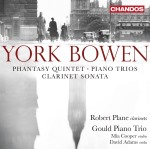 The music of York Bowen (1884-1961, Britain) is undergoing a deserved renaissance with a number of labels contributing to the cause. He wrote three trios, which span much of his compositional life. The first, in d minor, is a single movement written in his teens, the Rhapsody from post-WW1 and the third, in e minor, after WWII. My pick is the Rhapsody trio, which has the best balance of lyricism and energy. The excellent Chandos recording, with two clarinet chamber works of equal quality, is the only place to get all three (review). I haven’t heard the Dutton release, but my colleague Michael Cookson has recommended it highly, and given a detailed analysis of the two mature works. It has been re-issued at a bargain price bundled with the first volume of his chamber music.
The music of York Bowen (1884-1961, Britain) is undergoing a deserved renaissance with a number of labels contributing to the cause. He wrote three trios, which span much of his compositional life. The first, in d minor, is a single movement written in his teens, the Rhapsody from post-WW1 and the third, in e minor, after WWII. My pick is the Rhapsody trio, which has the best balance of lyricism and energy. The excellent Chandos recording, with two clarinet chamber works of equal quality, is the only place to get all three (review). I haven’t heard the Dutton release, but my colleague Michael Cookson has recommended it highly, and given a detailed analysis of the two mature works. It has been re-issued at a bargain price bundled with the first volume of his chamber music.
|
Performers |
Label |
Catalogue Number |
Coupling(s) |
|
Endymion Ens (Rhapsody & E minor) |
Dutton |
CDLX7115 |
Horn quintet |
|
Gould Trio (all) |
Chandos |
CHAN10805 |
Clarinet trio & quintet |
Adolf Busch (1891-1952, Germany) is better known as a violinist and leader of the Busch quartet, but his compositions have started to attract some attention in the last few years. The two trios recorded here, from 1919 and 1931, are certainly of a style more akin to the late nineteenth century, though with a slight astringency reflecting the times in which they were written. The second trio is more interesting, lighter and somewhat of a French feel to it. However, neither really made much impression on me. They have little in the way of attractive melodies, and tend to ramble somewhat.
Our
reviewer had a better experience than did I.
Ravinia Trio
(+ Piano quartet)
CPO 7775282
Alan Bush (1900-1995, Britain) wrote wrote his
Concert Studies in 1947 (thanks to Peter on the Messageboard for
letting me know about this). I haven't heard them but they
have been well described and received by my colleagues (review
~~
review). While the ASV label is long since gone, this
release is still listed on Amazon. The choice between the two
recordings is fairly clear: Romantic or middle-twentieth century
British.
| Performers |
Label |
Catalogue Number |
Coupling(s) |
| Barbican Trio |
ASV |
CDDCA646 |
Ireland: Phantasie, Mendelssohn 1 |
| Music Group of London |
Lyrita |
SRCD256 |
Bush: Piano works; Berkeley: Sextet, sonatina;
Rawsthorne: Clarinet quartet |
Leo Brouwer (b. 1939, Cuba)
is
best known for his guitar music, but he is prolific in other genres,
including two works for trio: Manuscrito antiguo and Sones y
danzones. Both have impressed me on sampling through Spotify.
There are occasional harsh dissonances, but rarely do they last long
and are smoothed out by interesting rhythms and gentle melodies.
Neither release is widely available, which is a shame.
|
Performers |
Label |
Catalogue Number |
Coupling(s) |
|
Trio Arbos (Sones) |
Ensayo |
9821 |
Gianneo 2, Piazzolla: Oblivion, Muerte |
|
Trio Bretón (Manuscrito) |
Several |
SCD818 |
José Turina, Joaquin
Turina 2 |
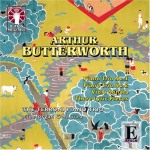 The late Arthur Butterworth (1923-2014, Britain) was a valued contributor to this website, and an somewhat under-appreciated composer, writing in a pared-back Romantic style, with Sibelius frequently mentioned as influence. His two trios are from the later part of his career – 1983 & 2004 – and Hubert Culot describes the release as most desirable. They strike me as being slow to offer up their qualities, being tonal and conservative, but lacking somewhat in melodic interest.
The late Arthur Butterworth (1923-2014, Britain) was a valued contributor to this website, and an somewhat under-appreciated composer, writing in a pared-back Romantic style, with Sibelius frequently mentioned as influence. His two trios are from the later part of his career – 1983 & 2004 – and Hubert Culot describes the release as most desirable. They strike me as being slow to offer up their qualities, being tonal and conservative, but lacking somewhat in melodic interest.
| Performers |
Label |
Catalogue Number |
Coupling(s) |
| Terroni Trio |
Dutton |
CDLX7164 |
Viola sonata |
The two trios of Sylvie Bodorova (1954-, Czech) – Prefigurations (1983 - review) and Megiddo (2001 - review) – are predominantly forbidding and bleak, and not really to my taste, but I do perceive a quality in them, so that those who are of a more modernist bent than me, should enjoy, if that is the correct word, them.
|
Performers |
Label |
Catalogue Number |
Coupling(s) |
|
Eben Trio (Prefigurations) |
Arco Diva |
UP01432 |
Mahler: Piano quartet, Semtana, Suk: Elegy |
|
Puella Trio (Megiddo) |
Arco Diva |
UP01142 |
Eben, Fiala |
Music for Dancers by David Braid
(1970-, Britain) doesn't really strike me as being rhythmic
enough to dance to, but that may be my ignorance of modern dance.
Its brittle lyricism has some appeal, the harsher moments less so.
Kenji Bunch (b. 1973, USA) is a
prolific composer writing in an uncomplicated idiom, incorporating pop
simplicity and jazz harmonies and rhythms within classical forms.
Swing Shift is somewhere between contemporary classical and
contemporary jazz: the subtitle of Groovebox Variations should give you
some hint as to the nature of the work. I quite liked its verve, but I
wasn't hearing it as a piano trio. Dies Irie and
Magic Hour are beautifully lyrical, but in a fairly simple style.
Slow Dance, his most recorded work, is more complex and
interesting: the Trio Arbos version has been
reviewed here. The Fantasy on Porgy and Bess has been described in reviews as
"resourceful and suave". It's not too difficult to work out what
you wil be getting, but if that appeals, you may find it hard to track
down, as it seems not to have been picked up by Warner Classics after
their acquisition oif the EMI catalogue.
| Performers |
Label |
Catalogue Number |
Coupling(s) |
| Ahn Trio (Slow dance) |
Warner Classics |
5570222 |
Bernstein, Bunch: Concerto, Ewazen: Diamond world,
Piazzolla: Oblivion; arrangements |
| Ahn Trio (Dies Irie, Magic Hour) |
RCA |
886972720722 |
Lullaby for my Favorite Insomniac |
| Trio Arbos (Slow dance) |
Non Profit Music |
NPM1012 |
Schoenfield: Cafe music, Grundman: Walk, Kats-Chernin:
Calliope dreaming, Mozetich: Scales |
| Atlanta Chamber Players |
MSR Classics |
MS1190 |
Harbison: Songs, Della Joio: Flute Trio, Mozart:
Kegelstatt Trio |
| Eroica Trio (Fantasy) |
EMI |
07351 |
Bernstein: West Side Story, O'Connor 1 |
| SPARK (Swing shift) |
Ars Produktion |
ARS38084 |
Numerous short works |
Michael Brimer (b. 1933, South Africa/Australia) is the pianist of the Australian Trio, a highly regarded ensemble of long standing in his adopted country. His trio from 2001 has been described by my colleagues (review) as “earnest”, “satisfying”, “grave” and “unsettling”. It is written in an approachable but not undemanding style, and is worthy of a listen, though its only release is on a 4 disc anthology of his Trio’s recordings.
| Performers |
Label |
Catalogue Number |
Coupling(s) |
| Australian Trio |
ABC |
4765235 |
Collection |
Yehezkel Braun (1922-2014, Israel) wrote six trios,
all from the 1980s onwards, four of which have been recorded.
It is unfortunate that three are included on a very obscure Israeli
label, which is not readily available, as the samples I have heard
are very enjoyable. The Gramola is easily obtained and very
recommendable, though the companion pieces are unusual.
Psalterion adds the ancient stringed instrument, the psanterin,
and the other is a song cycle for mezzo and trio.
| Performers |
Label |
Catalogue Number |
Coupling(s) |
| Amber Trio |
Beth Hatefutsoth |
CC005 (1-3) |
-- |
| Gramola |
98766 (4) |
Day and Day, Psalterion |
In 2009 William Bolcom (1938-, USA) contributed a
gentle and wry one movement trio - Haydn and Go Seek - as
part of the "Homage to Haydn" project by the Haydn Trio Eisenstadt,
which resulted in 18 new trios from composers around the world.
| Performers |
Label |
Catalogue Number |
Coupling(s) |
| Haydn Trio Eisenstadt |
Capriccio |
C7020 |
Collection |
I can't say that the trio by Eberhard Böttcher (1934- ,
Norway) really did much for me. Not modernist at all,
but it just lacked interest. Clearly, others think more of his
music as quite of a deal of it has been recorded.
| Performers |
Label |
Catalogue Number |
Coupling(s) |
| Trio Berlin |
Hemera |
HCD2914 |
Cello sonata, Violin sonatina & other chamber works |
To finish, there are a few recordings which are either modernist or
I haven't been able to hear even samples and don't know the
composers.
| Composer |
Work |
Performers |
Label |
Catalogue Number |
| Kurt Bossler |
Trio |
Kastner, Bouchez, Kondo |
Querstand |
VKJK1119 |
| Trio Berlin |
Hemera |
?? |
| Martin Boykan |
Trio 2 |
Berman, Stevens, Curry |
CRI |
841 |
| Nikolaus Brass |
Trio |
Becker, Wharton, Guggenberger |
Wergo |
WWE1CD20235 |
| Martin Bresnick |
Trio |
Jupiter Trio |
Cantaloupe |
CA21041 |
| Earle Brown |
Music for Violin, Cello &
Piano |
Not known |
Mode |
179 |
| Raimondi, Soyer, Tudor |
New World |
80650 |
| Not known |
Wergo |
WER69312 |
|
Joanna Bruzdowicz |
Trio dei Due Mondi |
Strobel, Strahl, Szreder |
Pavane |
ADW7355 |
| Nicholas Buc |
Trailer Music |
Benaud Trio |
Melba |
MR301139 |
| Hans-Georg Burghardt |
Fantasy-Trio |
Malinconia |
Cornetto |
20010 |
Wishlist
Mélanie Bonis, Suite Orientale
Sergei Bortkiewicz – Trio, op. 38 (1928)
Rutland Boughton - Celtic
Prelude (1917) Piano Trio (1948)
Joseph Boulnois – Trio in B (1918)
Francisco Braga – Trio
Ignaz Brüll – Trio in E flat, op. 14
